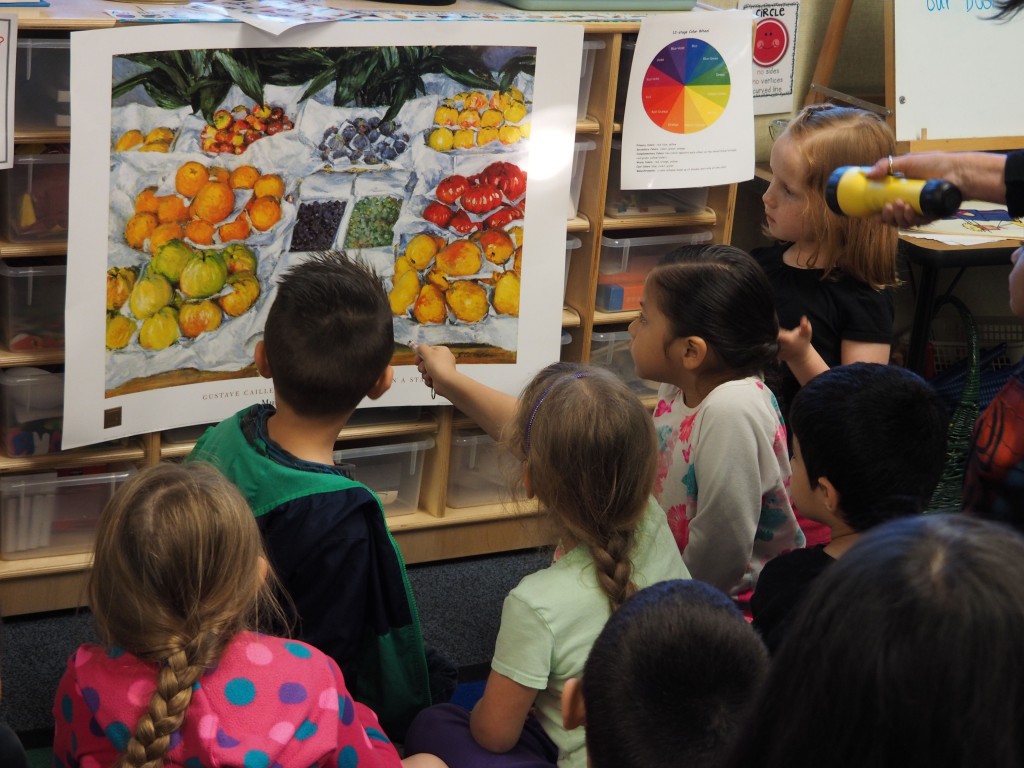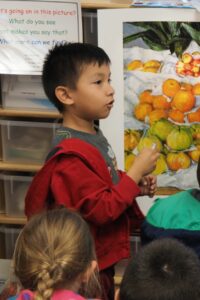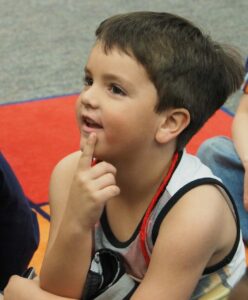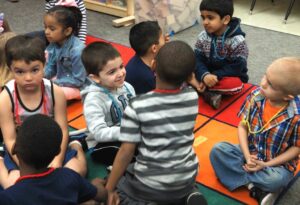 Liv Ames for EdSource
Liv Ames for EdSourceArt lessons for pre-kindergarten students are moving beyond finger paints and into the worlds of van Gogh, da Vinci and Rivera.
Teachers in a number of districts in California are using classic works of art to inspire some of the youngest students to observe closely, think critically and discuss respectfully – all key elements of the Common Core approach to learning.
By looking closely together as a class at a Picasso or a Cezanne, 4- and 5-year-olds are learning how to observe and translate their thoughts into language and listen and respond to multiple perspectives.
This approach for K-12 students was developed about 20 years ago by the co-founders of Visual Thinking Strategies, a nonprofit based in New York that provides training in the method to schools and art museums. More recently, the nonprofit has introduced the concept to pre-K classes.

Liv Ames for EdSource
Alexander Chitay, a transitional kindergartner, uses a laser light to point out what he wants to discuss about the painting.
It appears to be growing in its appeal since the introduction of the Common Core standards adopted by California and 42 other states. During the past two years, the nonprofit’s national trainings of educators have doubled, said Amy Chase Gulden, national program director. The nonprofit has trained teachers in more than 70 schools in the Bay Area, Northern California and Los Angeles.
Research studies on the method have shown that students in classes where the visual thinking program was used had a better understanding of visual images, exhibited stronger growth in math and reading, and showed better social-emotional growth than students in classes that did not use the program. The approach was particularly effective for English learners.
The visual thinking method asks three questions of young students: What’s going on in this picture? What do you see that makes you say that? What more can we find?
This approach teaches students how to take the time to observe closely, describe what they see in detail and provide evidence for their observations, Gulden said, “the kinds of skills that the Common Core asks for.”
Such programs are part of a new movement in English language arts to develop visual literacy, said Kim Morin, a professor who teaches integrated art at Fresno State University.
“It kind of came in with the Common Core – a more holistic approach,” Morin said. “As society becomes more digital, it’s not enough to just be able to read words; we have to be able to read images.”
“We have to be able to look at an image and understand it, not just react to it,” she said.
Some districts, such as San Francisco Unified, were applying this method long before Common Core standards were adopted. When Elizabeth Levett, who teaches kindergarten at George Peabody Elementary in San Francisco, introduced the Visual Thinking Strategies program into her classroom about eight years ago, she said she saw the growth in her students’ language “right away from one lesson to the next.”
“They’ll start the year with ‘I see a ball,’” she said. “After that it snowballs. It’s amazing.”
“We’re giving them language they wouldn’t normally have in a context that is meaningful to them right in the moment,” said Elizabeth Levett, a kindergarten teacher at George Peabody Elementary in San Francisco.
Teachers respond to a student’s comment on a painting by paraphrasing the comment and taking it to the next level, Levett said. Perhaps a student will notice a figure. The teacher will then say, “so you are noticing this figure in the left-hand foreground of the painting?”
“We’re giving them language they wouldn’t normally have in a context that is meaningful to them right in the moment,” she said.

Liv Ames for EdSource
Donavon Quezada, 4, is looking closely at a painting in his transitional kindergarten class in Fresno.
It is important for the teacher to paraphrase the student’s comment in such a way that the student feels understood and the rest of the group can grasp what the student has said, Gulden said. Teachers have to let go of their agendas and ideas and follow the child, she said, another Common Core approach to learning.
Sometimes the student may be searching for a word and the teacher can restate the student’s idea using the word, she said.
The approach “builds vocabulary and fluency,” Gulden said. The method is particularly effective with recent immigrants, she said.
School psychologist Julie Montali also finds the method works well with English learners. Montali has an art degree and has been trained in the visual thinking method. She developed a similar curriculum for pre-K students at Fresno Unified with English language arts instructional coach Claudia Readwright.
“Kids act as language models for other kids,” Montali said. “Often another child is the best teacher.”
The open-ended approach to discussing the painting also equalizes the experience, she said. The art is new for everyone, sometimes including the teacher. The discussion of the ideas inspired by the art does not require prior knowledge, and there are no wrong answers. That makes it easier for shy students or those learning English to participate, she said.
Children also respond to the ideas of other students and learn to look at things from another person’s perspective, Montali said. They keep the discussion moving with minimal intervention from the teacher, the kind of self-directed learning emphasized by the Common Core.
In the process of discussing the paintings, the children learn how to have different opinions without rancor, Levett said. They use terms such as “I’m noticing” or “I want to build on what he said.”
Juliet James, who has been using the method to teach 2nd-graders at Old Adobe Elementary School in Petaluma for the past five years, said students are polite. “They’ll say, ‘I disagree with Karen because of this reason.’ They have to give the evidence,” she said.
Using high-quality artwork is also important, Morin said, particularly in terms of stimulating observations by the children.
“You can keep going back to a masterwork and see something different every time,” she said. “If it’s not a high-quality work, it doesn’t have that depth.”

Liv Ames for EdSource
Students in a transitional kindergarten class in Fresno talk among themselves about the work of art they just discussed as a class.
On a recent day, the transitional kindergarten students in Yvonne Stout-Barrett’s class at Figarden Elementary School in Fresno eagerly gathered around a print called “Fruit Displayed on a Stand” by the 19th century French artist Gustave Caillebotte. They began talking about what they saw, including shapes and colors. Building vocabulary by discussing shades such as magenta, carmine or chartreuse is one way talking about art builds more sophisticated language.
Teachers say they see the effect of the method in other subject areas.
Brian Harrigan, who teaches preschool students at San Francisco Unified, said that since he has used the visual thinking method, he notices the difference when he is reading a story to the children.
“They start describing things in the picture more fully,” he said.
Such close observations of art help children learn to visualize, which helps them when they begin to read, Morin said. “If you can visualize what you are reading, you are a stronger reader rather than just reading word-to-word,” she said.
The same methods of showing evidence for what you are thinking or saying can work with deconstructing a story or a mathematical graph, Gulden said.
James uses the method in teaching all subjects to her 2nd-graders, such as when she introduces the 100s number chart to discuss place value.
“They will talk about it being a grid, how each space is equal,” she said. “They will notice the numbers going across are 1 to 10. I then come in and say that the horizontal numbers are 1 to 10. Then they will notice the vertical numbers are counting by 10s.”
“Very often young children have an almost deeper perception of what they’re seeing,” said Fresno State professor Kim Morin. “They don’t have preconceptions. They don’t think: ‘I don’t get it.’”
Fresno has decided to implement the curriculum by adding it to a grade each year, beginning with preschool children last year and transitional kindergartners this year. The integrated approach will follow the children as they move through the K-12 system.
Starting young has its advantages, Morin said. “Very often young children have an almost deeper perception of what they’re seeing,” she said. “They don’t have preconceptions. They don’t think: ‘I don’t get it.’”
In a research paper on talking about art with young people, David Bell, an associate professor at the University of Otago in New Zealand, says that “children are less inhibited than many adults in their engagement with artworks.”
“They may be surprised, entertained, puzzled or challenged by what they see,” he said. “They are also likely to express their various responses to the works in exclamations, comments or conversations.”
Teachers laud the method for slowing things down in a fast-paced world and building on young children’s natural ability to learn through observing.
“Everyone is worried about kids having access to technology,” Levett said. “They’re too little. They need to learn how to look slowly, really observe. Everything in technology is click, click, click. This method hones the craft of looking deeply and really listening to each other.”
To get more reports like this one, click here to sign up for EdSource’s no-cost daily email on latest developments in education.


Comments (18)
Comments Policy
We welcome your comments. All comments are moderated for civility, relevance and other considerations. Click here for EdSource's Comments Policy.
Penny Higgins 2 years ago2 years ago
This sure has enlightened me more about this specific aspect. Thank you!
Please see also my blog
Why Kids Need Exposure to Children’s Literature
Cynthia Silhan 3 years ago3 years ago
I frequently do art with my young students. I love how this article made me think of the benefits of art, such as building language and vocabulary in our young students.
Victoria Oderinde 3 years ago3 years ago
Children’s creativity expands through art appreciation.
Thanks for this well-researched article.
Dennis Sanchez 4 years ago4 years ago
I thought it was cool when you mentioned that teachers are using art to help their students think critically. My daughter loves going to art museums and looking at all the different paintings. Every time there is an art exhibition, she always wants to spend all of her time there.
Nicole Tingson 4 years ago4 years ago
This should be preached in kindergarten and schools, in churches, so important for a child’s well being!
Bunny garrett 4 years ago4 years ago
Absolutely fantastic great program
Rhianna Hawk 4 years ago4 years ago
It's really great to know that teachers are working hard to incorporate arts into children's learning to create more enriching learning activities, as you said. I'm going to be moving my family to a new city, and so our daughter is going to be starting kindergarten in an entirely new city that I don't know very well, so finding the best learning experience for her will be important to me. We'll definitely have to look … Read More
It’s really great to know that teachers are working hard to incorporate arts into children’s learning to create more enriching learning activities, as you said. I’m going to be moving my family to a new city, and so our daughter is going to be starting kindergarten in an entirely new city that I don’t know very well, so finding the best learning experience for her will be important to me. We’ll definitely have to look into those Visual Thinking Strategies you talked about, as well, and see what schools are incorporating them.
Caroline Gallagher Lavery 5 years ago5 years ago
Excellent! I have been teaching art and design to pupils aged 11-18 years old in Northern Ireland for 28 years and have always been a firm believer that children should be encouraged to evaluate their own work and others using visual language words. With practice children learn to express their ideas through observing in a natural way and quickly gain confidence to use a range descriptive words to confidently articulate a deeper perception of what they’re seeing.
Asasa Academy 5 years ago5 years ago
Art is a creative way to help our kids to learn in a better way. Nice post and thanks for sharing the information. And yes thanks again for sharing the research studies. Very helpful.
Suzanne 6 years ago6 years ago
You make a great point about the need to slow down, look deeply, and observe. Impulsive clicking in today's internet age will replace in depth analysis and appreciation of art in the next generation - if we let it. We felt it was so important to get young children exposed to classic works of art that we created several fine art puzzles to get classic works by Renoir, Matisse, & Thomas Cooper Gotch. … Read More
You make a great point about the need to slow down, look deeply, and observe. Impulsive clicking in today’s internet age will replace in depth analysis and appreciation of art in the next generation – if we let it.
We felt it was so important to get young children exposed to classic works of art that we created several fine art puzzles to get classic works by Renoir, Matisse, & Thomas Cooper Gotch. (We write more on the topic in our article at Amazing Wiz Kids’ blog.)
Aklim 6 years ago6 years ago
My comment is that we should have to learn as much as possible…!
Gary Ravani 8 years ago8 years ago
A "return" to art, as well as the social studies, in the schools is a pretty clear indicator of how far off track the self-styled reformers have been able to lead the system, ably assisted by a compliant media and politicians of course. The question society must ask itself, is why were they abandoned in the first place? I note two articles in this week's NY Times, Sunday Review. Both on the same page, "Best, Brightest--And … Read More
A “return” to art, as well as the social studies, in the schools is a pretty clear indicator of how far off track the self-styled reformers have been able to lead the system, ably assisted by a compliant media and politicians of course. The question society must ask itself, is why were they abandoned in the first place?
I note two articles in this week’s NY Times, Sunday Review. Both on the same page, “Best, Brightest–And Saddest,” by Frank Bruni and, “Where Are the Teachers of Color?” by Motoko Rich. The latter article was featured as a “link” by EdSource in the daily update earlier this week.
[Full disclosure: Motoko is a former student of mine, briefly, when she was in middle school. I was teaching Developmental Reading and Motoko had little need for “development” in those skills even then. She went on, as I recall, to attend Lowell in SF.]
In the Bruni article, he talks about “sentries” being stationed around Palo Alto near the commuter train tracks to prevent teenagers from committing suicide. There has been a “cluster” of such incidents of late in the “heart of Silicon Valley.” He cites research done showing thoughts of suicide are more and more prevalent in teenagers around the country. He makes the inference that more and more academic pressure put on students may be a causal factor in this phenomenon. He states: “They grow up with ‘AP’ classes galore, convinced that their futures hinge on perfect SAT scores and preternatural ‘GPAs.'” Bruni quotes a former dean at Stanford who lives in Palo Alto: “There’s something about childhood itself in Palo Alto, and communities like it, that undermines the mental health and wellness of our children.”
Bruni has a warning for another group too: “Does a hovering, exactingly prescriptive parenting put them in unforgiving boxes and prevent them their true selves and their true grit?”
Motoko’s article goes into the threats to another vital component of our schools, the teachers, and teachers of color specifically: “They are disproportionally assigned to to schools with large populations of children from low-income families and are subjected to ‘student discipline problems and lack of resources and lower salaries, with often more top-down and scripted curricula…”
It is a very good thing that schools may be allowed to turn their attention to other subjects than those the Titans of Tech have been demanding and that students may be able to explore their other talents not measured by any test score. And this for both ends of the academic and economic ladder. As Motoko’s article points out scripted, and demeaned, curricula are more common at schools with more disadvantaged students under threat of sanctions from low math and ELA scores, but at the other end (and I’ll get some argument here) AP classes are highly scripted also, and the teaching is definitely “to the test.”
Replies
Don 8 years ago8 years ago
Teachers are walking right down the garden path as they march their students into the testing rooms day after day between now and May and to take what test? Art and history? No, math and ELA, just as they have been doing for years under the failed NCLB and PSAA requirements of law, only now they'll walk that walk under the auspices of CCSS. There is one important difference though. These … Read More
Teachers are walking right down the garden path as they march their students into the testing rooms day after day between now and May and to take what test? Art and history? No, math and ELA, just as they have been doing for years under the failed NCLB and PSAA requirements of law, only now they’ll walk that walk under the auspices of CCSS. There is one important difference though. These new tests will be used for teacher evaluations in years to come. Teachers are in!
Chelsea Guray 8 years ago8 years ago
Thank you for this highly promising strategy. I will definitely apply this on my upcoming Summer Camp with 8-grader students.
Chelsea Guray 8 years ago8 years ago
Thank you so much for this highly promising strategy. I will apply this to my upcoming Summer Camp with my 8-grader students.
Margie Stratford 8 years ago8 years ago
Elizabeth Levett speaks to the heart of every actively involved grandparent of today's children growing up in this highly tech-oriented world. So often we are the ones who are able to sit in an unhurried spot, maybe a tree house or the floor of a child's room and really have a conversation and hear those beautiful thoughts and ideas come out. I love asking my young ones to "tell me about your drawing", or "when … Read More
Elizabeth Levett speaks to the heart of every actively involved grandparent of today’s children growing up in this highly tech-oriented world. So often we are the ones who are able to sit in an unhurried spot, maybe a tree house or the floor of a child’s room and really have a conversation and hear those beautiful thoughts and ideas come out. I love asking my young ones to “tell me about your drawing”, or “when did you first find this idea for your painting”. I hear absolutely pure and original words never spoken before and they enrich me to my common core!
Bless the educators who encourage creative and critical thinking in these youngsters!
Margie Levett Stratford
Susan Striket 8 years ago8 years ago
In my books " Meet the Masters" and "Young at Art " I wrote about how to teach preschool through age 6 using great masters of both art and literature. By the way, "Young at Art" is a registered trademark. I own it. Young children really can relate to contemporary art, and this is an ideal time to familiarize children with modern masters. They REALLY "get" Jackson Pollack! Read More
In my books ” Meet the Masters” and “Young at Art ” I wrote about how to teach preschool through age 6 using great masters of both art and literature. By the way, “Young at Art” is a registered trademark. I own it.
Young children really can relate to contemporary art, and this is an ideal time to familiarize children with modern masters. They REALLY “get” Jackson Pollack!
Eric Kamander 8 years ago8 years ago
I find this whole topic so fascinating. I never considered myself an art fan, and neither did my kids, but when we vacationed in D.C. we were all surprised how much more fun we had at the Hirshhorn Museum and Sculpture Garden than we did at the Air and Space Museum. http://t.co/FUi21C7GVE